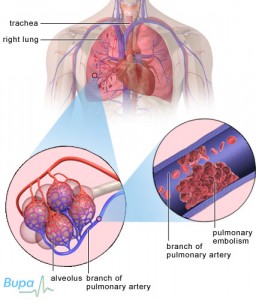Pulmonary embolism - diagnosis, symptoms and treatment

What is Pulmonary Embolism
Pulmonary embolism - a BLOOD clot that blocks the flow of blood through the main pulmonary ARTERY, the right or left pulmonary artery, or branching arteries within the lobes and segments of the LUNGS. Untreated pulmonary embolism can cause respiratory distress or death; about 30,000 people die each year in the United States as a result of pulmonary embolism.
Pulmonary embolism is a life-threatening condition that requires emergency medical care.
Pulmonary embolism is a potential complication of blood clots that develop within the veins, typically the deep veins of the legs. It most commonly develops as a consequence of venous stasis, in which the blood moves sluggishly through the veins. The blood’s slow movement allows blood to pool, permitting clots to begin to form especially on and around the valves in the veins. Clot fragments or the entire clot can break free, floating through the bloodstream.
Because the veins become larger as they approach the HEART, the bloodstream easily carries the clots through the right heart and into the pulmonary arteries and the lungs. Occasionally the clot that causes a pulmonary embolism originates in the heart’s right atrium. Large clots can occlude (block) the pulmonary arteries at the point where the right and left pulmonary arteries diverge (bifurcation of the pulmonary artery).
As a consequence of the intimate correlation between alveolar function and the flow of blood through the capillary network that enmeshes the alveoli, the loss of capillary flow resulting from pulmonary embolism effectively shuts down all alveoli beyond (distal to) the site of the occlusion. Any loss of functioning alveoli subsequently limits the ability of the lungs to convey oxygen to the blood. The larger the occluded artery, the more immediate and significant the pulmonary consequences.
Symptoms of Pulmonary Embolism and Diagnostic Path
The symptoms of pulmonary embolism vary widely and can be subtle or may be as severe and immediate as those of HEART ATTACK, and are similar. Such symptoms include
- sudden, severe CHEST PAIN
- DYSPNEA (difficulty BREATHING)
- diaphoresis (breaking into a cold sweat)
- HYPOTENSION (low BLOOD PRESSURE)
- TACHYCARDIA (rapid heart rate)
- TACHYPNEA (rapid BREATHING)
A person who experiences a massive pulmonary embolism may have little time between feeling fine and going into shock and cardiovascular collapse. Smaller emboli or recurrent (chronic) pulmonary embolism episodes generally produce milder variations of these same symptoms along with productive COUGH and HEMOPTYSIS (blood in the SPUTUM).
The diagnostic path seeks immediately to determine whether the symptoms are cardiovascular (heart attack) or pulmonary. An ELECTROCARDIOGRAM (ECG) does not show evidence of acute cardiac injury in pulmonary embolism, which is the first major point of differentiation. Arterial blood gases show how severely the pulmonary embolism is affecting the body’s oxygenation. Diagnostic imaging procedures the pulmonologist may conduct include COMPUTED TOMOGRAPHY (CT) SCAN, MAGNETIC RESONANCE IMAGING (MRI), pulmonary angiography, and a specialized imaging procedure called ventilation/perfusion scan.
Treatment Options and Outlook
Hospitalization with intensive pulmonary support and immediate ANTICOAGULATION THERAPY is necessary for most circumstances of pulmonary embolism. The risk of death is highest within the first few hours of the embolism. Anticoagulation therapy targets preventing the formation of additional emboli. THROMBOLYTIC THERAPY (“clot buster” drugs) to dissolve the clots that have already formed is appropriate for some people. Surgery (either OPEN SURGERY or via catheterization) to mechanically break up the clot may be an option in severe situations. Recovery depends on the extent of lung affected, the existence of any underlying causes or health conditions, and the rapidity of diagnosis and treatment. People who recover from pulmonary embolism often require ongoing anticoagulation therapy though do not have significant permanent lung damage.
Risk Factors and Preventive Measures
Pulmonary embolism is most likely to occur in people who have restricted venous flow due to lower extremity VARICOSE VEINS or incompetent veins (veins that have lost elasticity and valve function), who are physically inactive, or who have recently had surgery or a major trauma (which means the body is forming clots for HEALING and also usually means limited physical movement). People who have untreated ATRIAL FIBRILLATION have increased risk for pulmonary embolism. OBESITY also increases the risk for pulmonary embolism because it exerts additional resistance against the blood flowing through the veins. People who have an increased tendency to form clots (hypercoagulation) are also at increased risk of developing a clot or pulmonary embolism. Research suggests that as many as 80 percent of people who have DEEP VEIN THROMBOSIS (DVT) experience frequent pulmonary emboli. About half of the people who have one pulmonary embolism experience subsequent episodes.
Prevention often incorporates ongoing ANTICOAGULATION THERAPY in people at risk for pulmonary embolism, including those who have had a previous episode. Support stockings help the leg muscles to work more efficiently in massaging blood through the veins. For someone who has never had a pulmonary embolism, regular physical activity and maintaining healthy body weight help to lower the risk for clot formation. Frequent stretching of the legs, and getting up to walk for a few minutes every hour, can maintain effective circulation and venous return when taking long air flights or train or automobile trips to lower the risk for both DVT and pulmonary embolism. Postoperative recovery and recuperation regimens incorporate early ambulation (walking within hours of surgery) as well as progressive ambulation (walking for longer times and distances as recovery continues). When the person cannot ambulate, preventive measures may include compression stockings and anticoagulant medications.
See also COAGULATION; MYOCARDIAL INFARCTION; PLATELET AGGREGATION; POSTOPERATIVE CARE; STROKE; SURGERY BENEFIT AND RISK ASSESSMENT; WEIGHT LOSS AND WEIGHT MANAGEMENT.